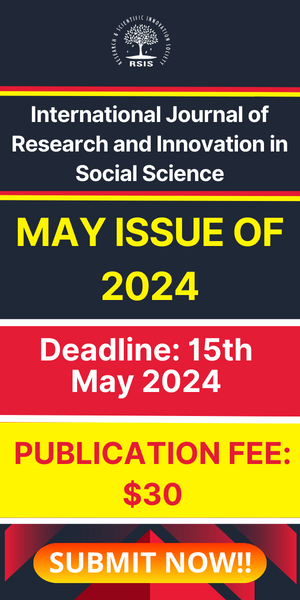Influence of Level of Satisfaction on Academic Performance of learners’ in Inclusive Primary School Settings in Western Kenya.
- April 8, 2022
- Posted by: rsispostadmin
- Categories: Education, IJRSI
International Journal of Research and Scientific Innovation (IJRSI) | Volume IX, Issue III, March 2022 | ISSN 2321–2705
Hesborn M. Chonge and Musima S. Mulambula
University of Nairobi, Kenya
Abstract: The government of Kenya has been committed to provision of relevant and quality education for all its citizenry including children with disabilities. Despite this relentless efforts, poor academic performance has consistently been registered in inclusive schools with higher population of those with physical disabilities, thus necessitating the need to explore if pupil’s satisfaction with inclusive primary school settings determines their academic performance. To achieve this objective, the study employed a convergent parallel mixed method design in five inclusive schools for pupils with physical disability. Data was generated from among 52 pupils with physical disability and 73 regular pupils who were purposively selected in inclusive schools for the pupils with physical disability. Data was collected through questionnaires which were analysed using percentages, means and chi square. The findings of the study among others revealed low academic performance in inclusive schools and ambivalence in terms of the level of satisfaction of the pupils with physical disability.
Key Words: Level of satisfaction; Academic Performance; inclusive schools
I. INTRODUCTION
According to Kauffman and Hallahan (2011), the beginning of a specialized education in Kenya can be followed to the end of the Second World War and has meanwhile been generally offered to all classifications of children with disabilities in learning. Instruction to these learners was just open in special schools until the 1970’s when units and other programs that were started. Special Needs Education has continually extended despite these children being a significant challenge in the education sector such as in Kenya. Consequently, education is viewed as a right for all learners and has been secured in various worldwide reports after the Universal Declaration of Human Rights in 1948. Therefore, advocates of The Education for All (EFA) and global conventions have shown that particular groups of children are especially prone to exclusion or have been denied of an opportunity to completely participate in the learning exercises occurring in formal or informal environments. Instruments such as United Nations Convention on the Rights of Persons with Disabilities (2006) and the Dakar structure for activity (UNESCO, 2000) emphasize on the right for education in regular school situation.
In the course of the last decade, inclusive teaching has been an arising idea/field. It is likewise known, in addition to other things, as Differentiated Learning, Universal Instructional Design or Universal Design of Instruction and Universal Design for Learning (Beaudoin, 2013). In the year 2008, the Salamanca Declaration push was repeated and extended at the gathering of the forty eighth meeting which was heled in Geneva in the UNESCO International Conference on Education. Inclusivity in education consequently requires perceiving disability as one of numerous types of variation in humans and inviting and seeing variety as an asset instead of an issue (Armstrong et at., 2011). Teaching in an inclusive setting accepts diversity to meet the different adapting needs and styles of learners. Connor and Goldmansour (2012) believe that inclusivity in education causes a circumstance where each child can be esteemed so that s/he experiences a feeling of having a place and where each learner is urged to accomplish their maximum capacity in every aspect of their development. Corresponding to this, an inclusive school should put adaptability and variety as an essential factor. This should be obvious in the substance of the educational program, construction of the school, convictions of staff, parents or guardians and learners and the target ought to be to offer each individual fitting instruction and ideal freedoms for progress (UNESCO, 2005).


